Turtles are fascinating creatures because they can live as long as humans, sometimes even longer. Their slow-moving mannerisms and rigid shield make them unique in the animal kingdom. In Texas, there are many areas where you can watch turtles bask in the hot sun and swim in the fresh, shallow water. Use this handy guide to find turtles in Texas, including which lakes and rivers you can visit for the best sightings.
1. Alligator Snapping Turtle
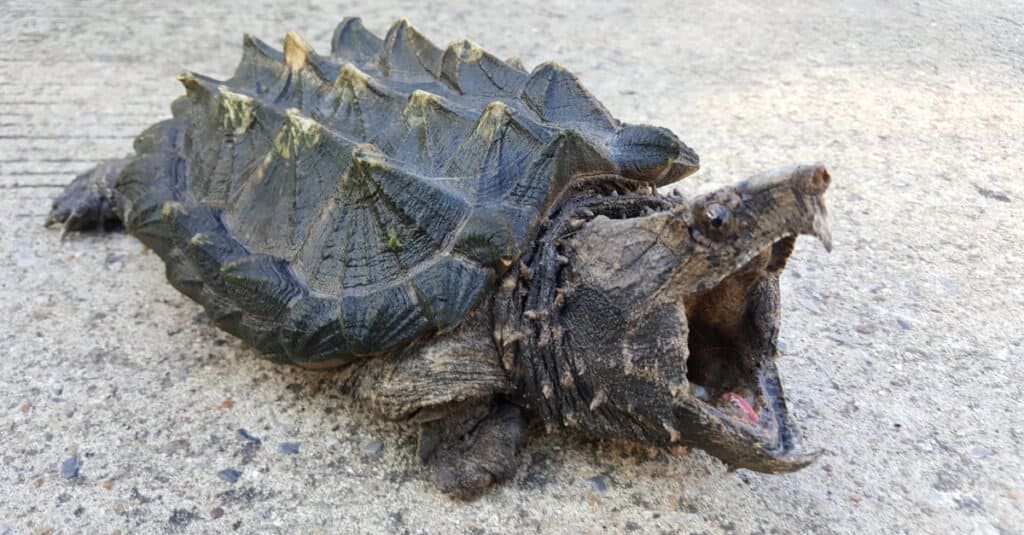
Alligator snapping turtles are in the eastern half of Texas, near the Trinity and Sabine Rivers.
©Sista Vongjintanaruks/Shutterstock.com
The alligator snapping turtle is the largest freshwater turtle in the world and can live up to 70 years. It is black or dark brown, and their shell is thick with pronounced spikes. Its beak-like jaws are comparable to other snapping turtle species. Alligator snapping turtles prefer to be at the bottom of rivers, lakes, swamps, and bayous, waiting for anything that swims past their jaws. They are threatened in Texas, and you will mainly find them in the eastern half of the state near Trinity and Sabine Rivers.
2. Desert Box Turtle
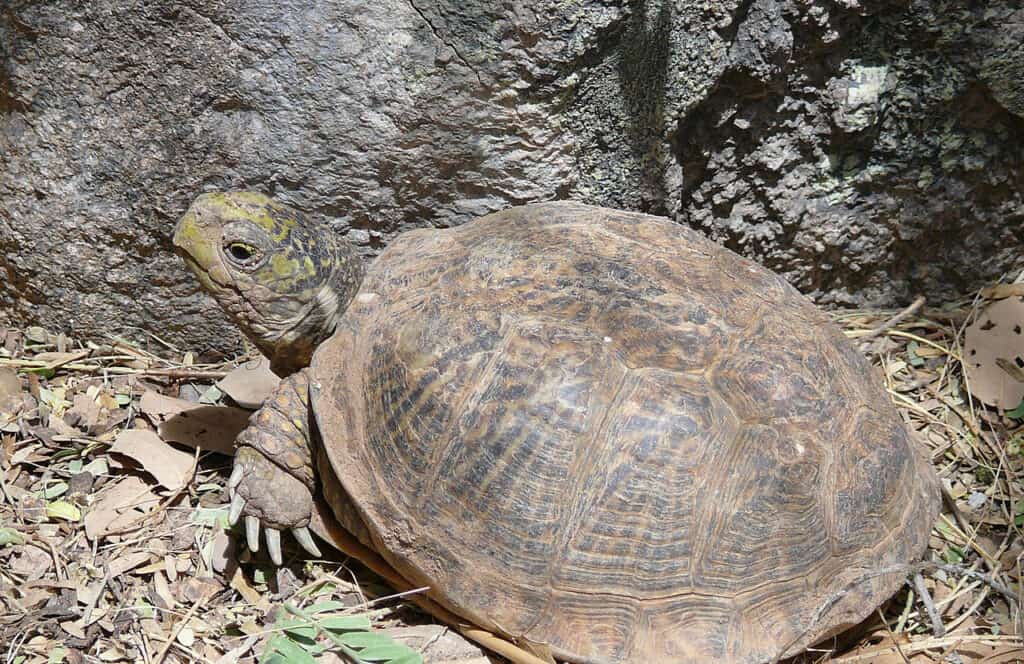
The desert box turtle lives in Southwest Texas.
©Sue in az / public domain – License
This turtle has a black or brown dome-shaped shell with yellow or orange spots and stripes. This species is suited to live in arid environments, and in Texas, you will find them in the Southwest past the Pecos River. You may also find them in open grasslands and meadows, where they will eat insects, fruit, and any kind of vegetation. Texas listed the desert box turtle as vulnerable.
3. Big Bend Mud Turtle
Big Bend mud turtles, also known as rough-footed mud turtles, have an olive or yellow-brown dome-like shell. They like to stay on the bottom of lakes, marshes, rivers, and swamps with a muddy or sandy floor where they can burrow and look for mollusks and invertebrates. This species is rare in Texas and is exclusively in the Southwest near the Big Bend region.
4. Ornate Box Turtle

Ornate box turtles live in open woodlands and grasslands.
©samray/Shutterstock.com
This species is colorful with orange and yellow patterns on its dome-shaped shell, and its skin has multiple yellow spots. Ornate box turtles live on land instead of water and like to inhabit open woodlands and grasslands. They forage insects and vegetation during the day within a relatively small territory. These turtles are vulnerable in Texas due to their shrinking habitat.
5. Big Bend Slider

The Big Bend slider is in Western Texas near Big Bend.
©effective stock photos/Shutterstock.com
Big bend sliders have an olive to dark brown shell with red, yellow, or orange patterns. They also have two distinguishing red spots on each side near their head. These turtles can be found in some parts of Western Texas near Big Bend, and they like to bask near rivers and ponds. They are mainly herbivores but will occasionally eat mollusks and invertebrates.
6. Three-Toed Box Turtle
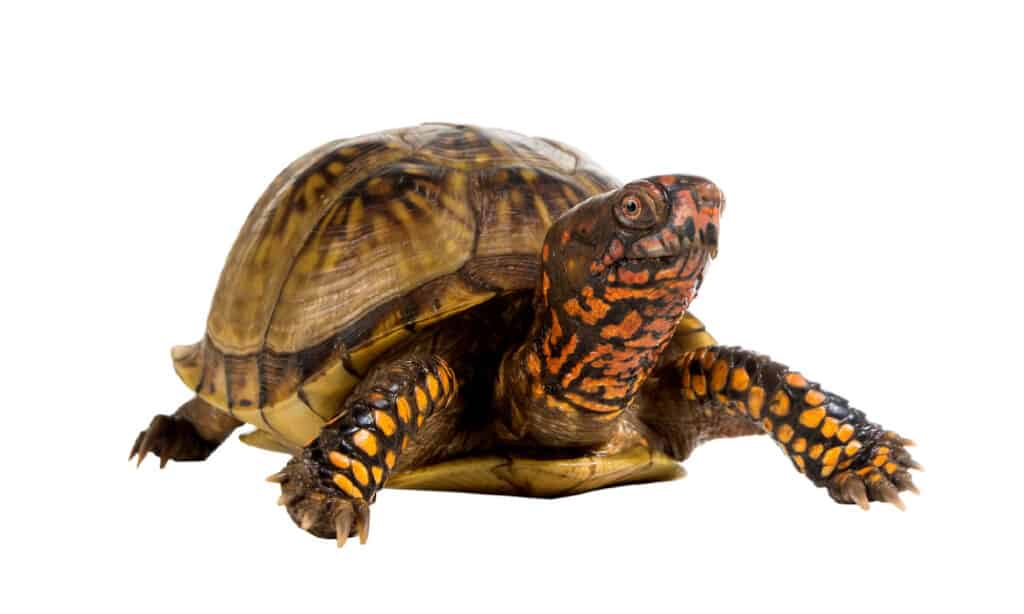
True to its name, the three-toed box turtle often has three toes on its back feet rather than the usual four.
©iStock.com/irin717
As its name suggests, the three-toed box turtle has three claws (or toes) on its hind legs. It has an olive or brown high-domed shell with yellow plastrons. This turtle lives in woodlands and grasslands in Eastern Texas, searching for earthworms, invertebrates, and vegetation.
The three-toed box turtle is between five and seven inches and can live to be 100 years old.
7. Cagle’s Map Turtle

The Cagle’s map turtle inhabits rivers south of the Guadalupe River and is endemic to Texas.
©RLS Photo/Shutterstock.com
The Cagle’s map turtle, named after herpetologist Fred Cagle, has a brown or olive shell with a map-shaped pattern. Its skin is dark brown to black and features white stripes. This subspecies is endemic to Texas and inhabits rivers south of the Guadalupe River. It prefers slow-moving water with plenty of vegetation, where it can feast on insects and aquatic vegetation.
8. Chicken Turtle

Chicken turtles live in marshes and ponds in East Texas.
©J. Norman Reid/Shutterstock.com
The western chicken turtle has a long, striped neck, a dark oval-shaped shell, and light-colored patterns. This semi-aquatic species prefers sluggish water in marshes, ponds, and canals, where it can quickly feed on fish and crustaceans. Western chicken turtles are a vulnerable species and in danger of losing their habitat, but you can still find them in parts of East Texas.
9. Common Musk Turtle

Common musk turtles inhabit regions of East Texas in marshes and bogs.
©Ryan M. Bolton/Shutterstock.com
Common musk turtles, or “stinkpots,” have plain dark shells with no distinctive markings except for two yellow lines on their neck. Their unusual nickname comes from their odorous musk glands to ward off predators. This species is only three to four inches and prefers slow-moving water with soft bottoms, like marshes and bogs. These nocturnal omnivores inhabit regions in East Texas.
10. Missouri River Cooter

The Missouri River cooter basks on logs near East Texas rivers.
©NasserHalaweh / CC BY-SA 4.0 – License
The Missouri River cooter has a dark-colored shell with numerous yellow curved, vertical patterns. This freshwater subspecies is semi-aquatic and prefers to be near rivers and streams, but may also venture into lakes and ponds. Missouri River cooters like to bask on logs near the river’s edge and dine on fruits, vegetables, and some insects. You will most often find them in East Texas.
11. Common Snapping Turtle
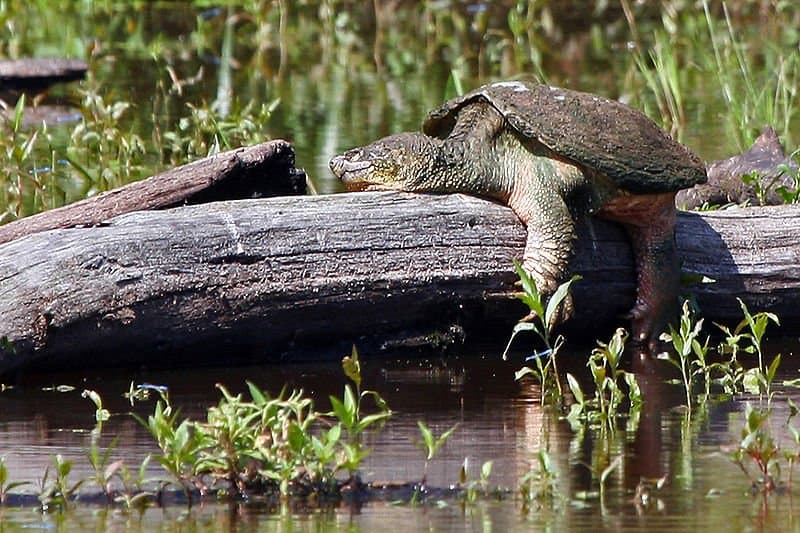
Snapping turtles are abundant in Texas, but most commonly in the south and west regions.
©https://www.flickr.com/people/sherseydc/, CC BY 2.0, via Wikimedia Commons – License
You can identify a snapping turtle by its beak-like mouth and its long legs, neck, and tail. It also has solid claws and a dark green or brown shell. Snapping turtles are freshwater turtles that are known for being aggressive and will hiss and bite when they feel threatened. You can find them in almost any fresh body of water in most Texas regions, except for certain parts of the south and west.
12. Rio Grande Cooter

The Rio Grande cooter inhabits the border between Texas and Mexico.
©Texas Turtles / CC BY-SA 4.0 – License
This river cooter has green, brown, and black-colored shells with red and yellow patterning. Its skin is dark brown with white stripes. You can find this freshwater, semi-aquatic turtle in the Rio Grande, forming the border between Texas and Mexico. It prefers water streams with plenty of vegetation and insects.
13. Guadalupe Spiny Softshell
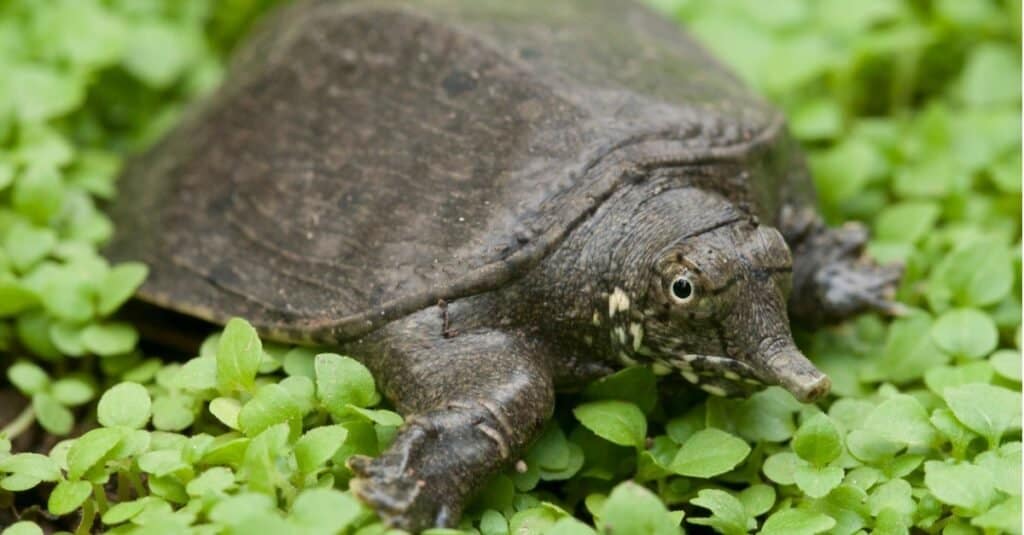
The softshell turtle has a long, tapered beak.
©dwi putra stock/Shutterstock.com
This softshell turtle has a leathery, round shell and ranges from a light brown to dark brown color. The exterior is covered in white spots, while the skin features black spots. Like all spiny softshells, the Guadalupe has a long, tapered beak, which they use to breathe while buried in the sand. It lives in many aquatic habitats, like the Guadalupe and Nueces Rivers in Southeastern Texas.
14. Texas River Cooter

Endemic to Texas, the Texas river cooter is mainly in the state’s Central portion.
©Bildagentur Zoonar GmbH/Shutterstock.com
The Texas river cooter is dark brown and black with no distinctive color markings on its shell. However, its skin is dark with yellow swirled patterns. You will find this cooter in rivers and streams, mainly in Central Texas but as far north as the panhandle. It likes to laze near the water’s edge, sometimes in stacks.
15. Midland Smooth Softshell

The midland smooth softshell inhabits most areas in Texas.
©Peter Paplanus / CC BY 2.0 – License
These dark-colored softshell turtles are plain, flat, and smooth, with no distinctive colors or patterns. They inhabit most areas in Texas, except for the eastern half, in most bodies of water with a sandbar. Midland smooth softshell turtles are active during the day, feeding on insects, mollusks, and crayfish.
16. Mississippi Map Turtle

The Mississippi map turtle is the most common mud turtle in Texas.
©iStock.com/Artur Bogacki
The Mississippi map turtle is the most common mud turtle in Texas and features a dark olive brown color with a pattern similar to a map. Its skin is dark and covered with thin yellow lines. This species is aquatic and never travels far from water. You will often find this turtle in parts of Eastern Texas near stagnant water with lots of vegetation.
17. Ouachita Map Turtle
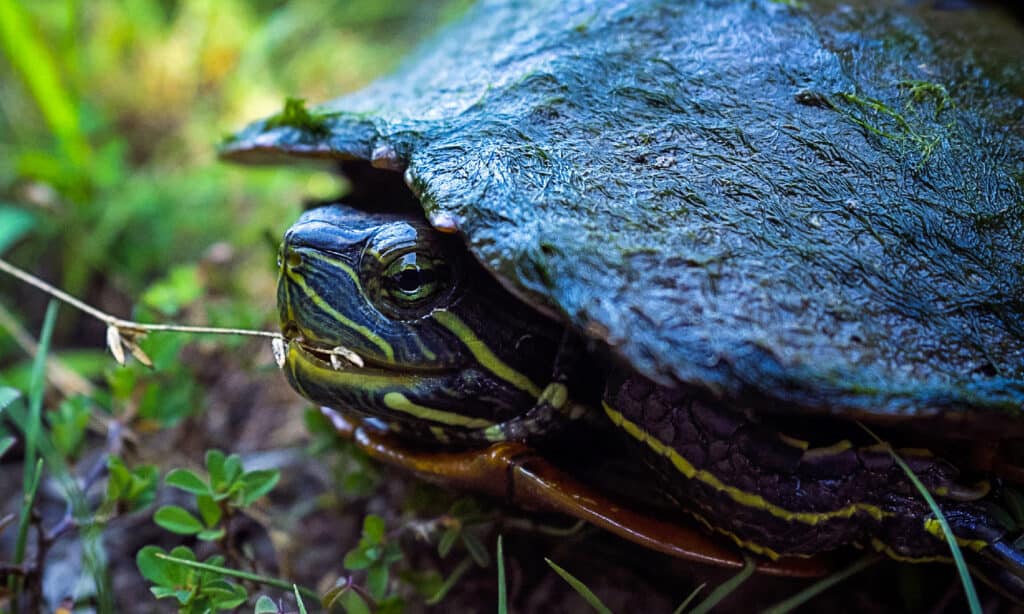
The Ouachita map turtle lives in the Neches and Sabine Rivers of East Texas.
©Stephanie’screativeImages/Shutterstock.com
Ouachita map turtles have similar coloring and patterns to that of other map turtles, but they are distinguishable by their lightly colored patches behind their eyes. These map turtles live near the Neches and Sabine Rivers in the extreme eastern parts of the state. You can usually see them in slow-moving streams, but they frighten easily and will jump away. They eat an aquatic omnivore diet of shrimp, larvae, algae, and plants.
18. Razorback Musk Turtle
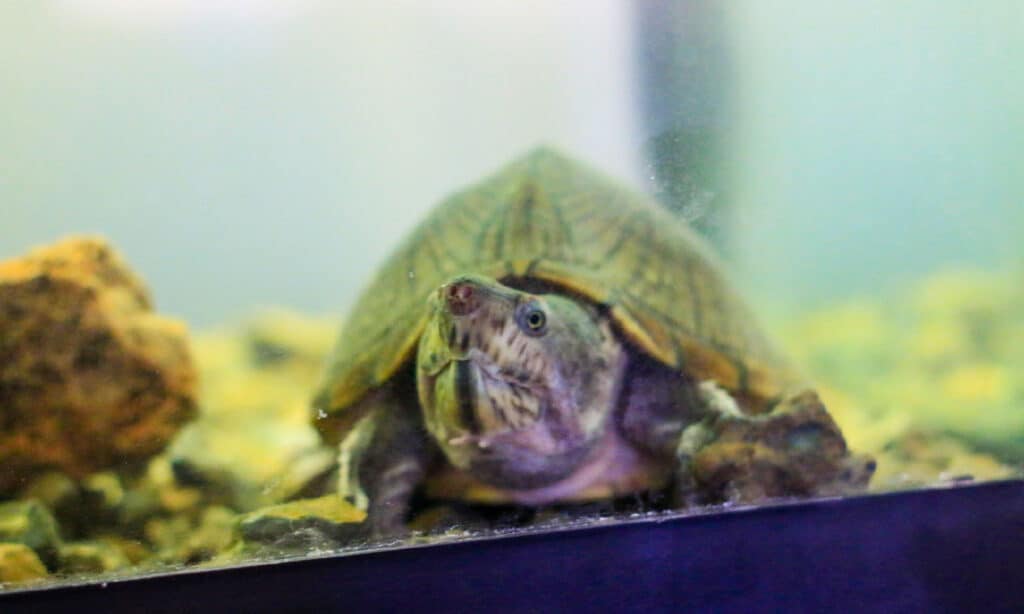
The razorback musk turtle lives in the swamps of Eastern Texas.
©iStock.com/mynewturtle
This species gets its name from the scutes or razor-like humps on its back. Its shell is dark brown, gray, or green, and its skin also varies in the same shades. Razorback musk turtles are mainly in the eastern half of Texas, near swamps and marshes. These carnivores hide in low-wetland vegetation and feed on mollusks, snails, and fish.
19. Texas Map Turtle
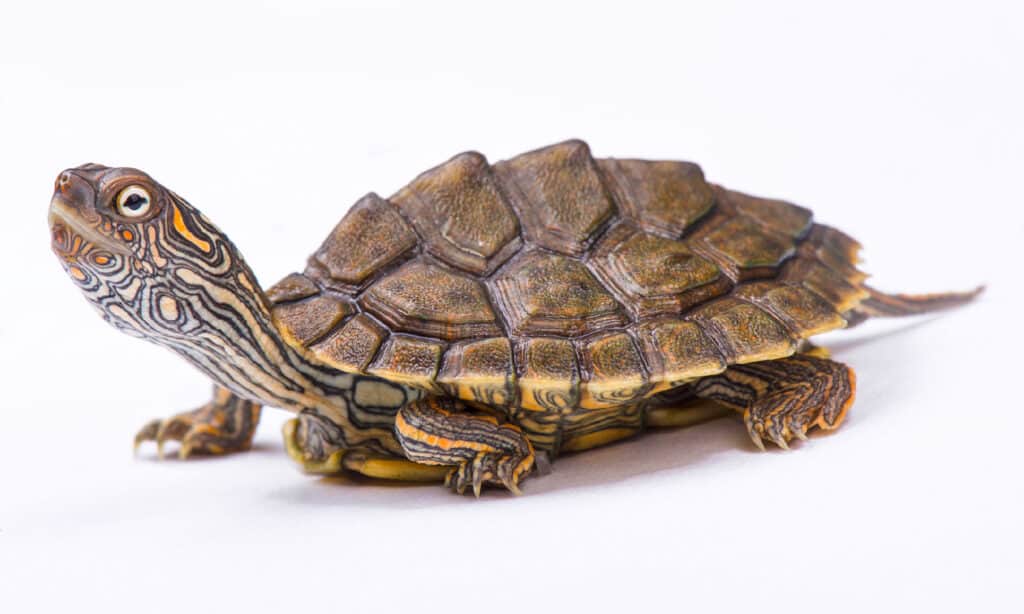
Texas map turtles inhabit areas near the Colorado River in Central Texas.
©iStock.com/reptiles4all
These map turtles have a spiky appearance with dark coloring, and yellow lines etched on their shell. You can tell this species apart from other map turtles by the three yellow dots near the base of their head. You can only find them near the fast-moving Colorado River in Central Texas. You will also find them in slow nearby streams, where they feed on insects and aquatic vegetation.
20. Red-Eared Slider
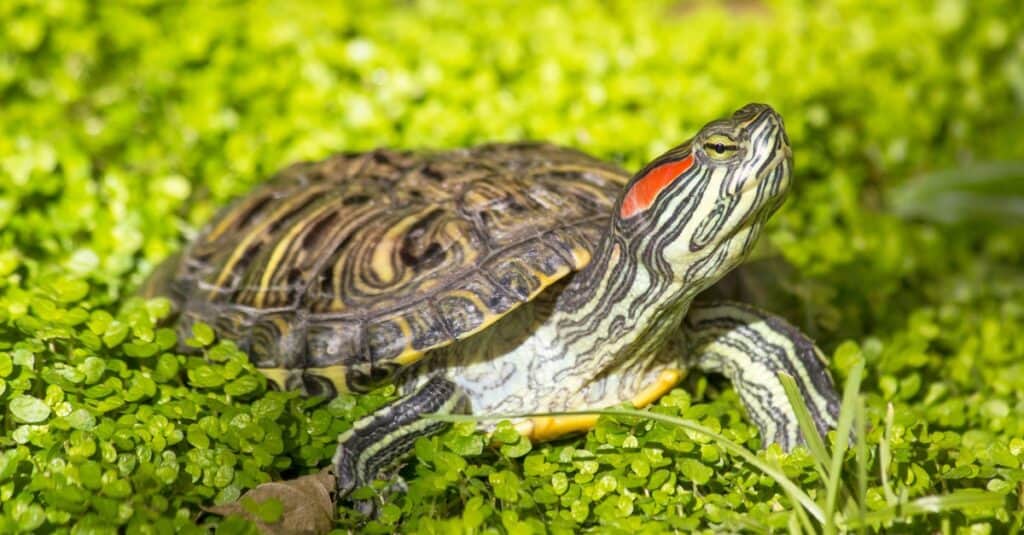
Red-eared sliders have red patches behind their eyes.
©xbrchx/Shutterstock.com
As its name suggests, this turtle has red patches behind its eyes, where a pair of ears would be. It also features a dark green shell and skin with yellow markings. Red-eared sliders are semi-aquatic, preferring to live near slow-moving rivers and lakes. You can find this species throughout most of Texas, and they are also popular pets.
21. Eastern Mud Turtle
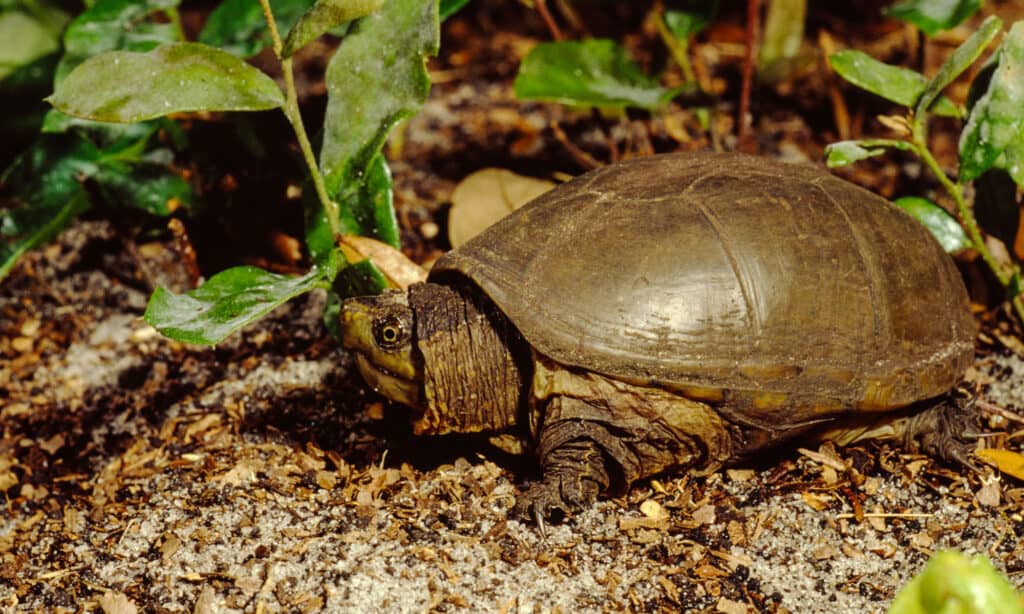
Eastern mud turtles live in swamps and marshes in East and Central Texas.
©Liz Weber/Shutterstock.com
These mud turtles have plain yellowish-brown shells shaped like smooth ovals. You can find them in East and Central Texas near shallow water, like swamps and marshes. They are semi-aquatic and will explore further away from water sources, hiding under mud to prey on earthworms and hibernate. Once in the water, they will eat fish and mollusks.
22. Southern Painted Turtle

Painted turtles live in Caddo Lake on the Louisiana border.
©WilleeCole Photography/Shutterstock.com
The southern painted turtle is conspicuous, featuring a dark brown or black shell with a bright red line running down its center. Its skin is also dark with yellow and red markings. All painted turtles live in freshwaters like rivers, ponds, and lakes. This species, in particular, is confined to Caddo Lake on the Louisiana border. Painted turtles are aquatic, preferring to bask near the water and eat frogs, mollusks, and vegetation.
23. Yellow Mud Turtle

Yellow mud turtles are widespread in Texas.
©Kayla Blundell/Shutterstock.com
Yellow mud turtles have a dome-shaped shell with the upper portion colored in black, brown, or green and the lower part a light yellow. Like other mud turtles, this species prefers lakes, swamps, rivers, or marshes with sandy or muddy bottoms. They are widespread in Texas, although rarely in extreme eastern regions.
24. Texas Diamond-Backed Terrapin
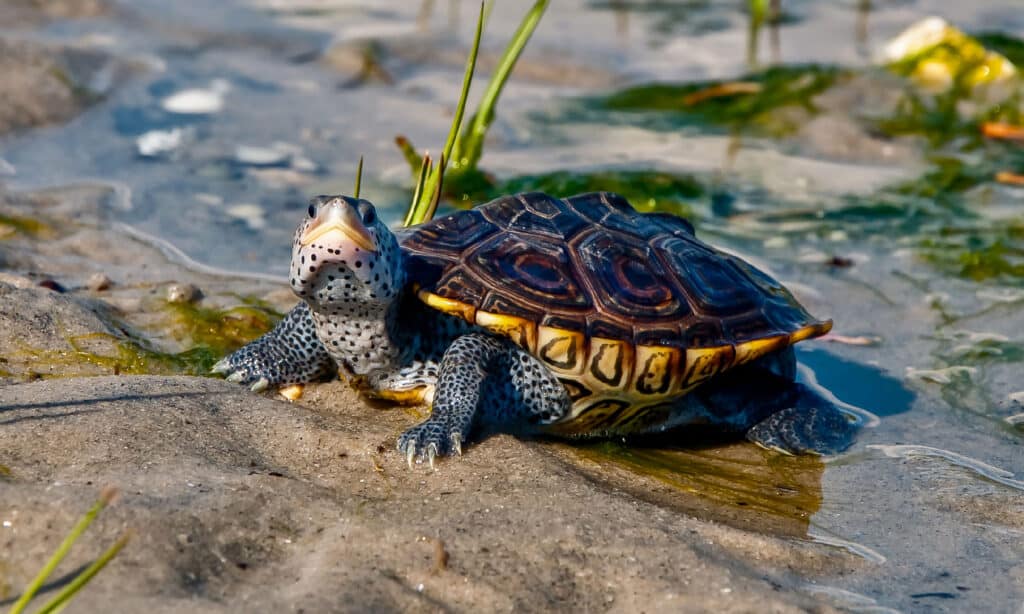
The diamond-backed terrapin lives in brackish waters near the Gulf Coast.
©iStock.com/JasonOndreicka
Its skin is light gray, covered in black spots, and its shell is a dark brown or green color with light brown spots. Different from most turtles in Texas, the diamond-backed terrapin lives in brackish water in coastal marshes. It is aquatic and swims in the water with its head poking out, feeding on crustaceans and shellfish. It’s probably no surprise that you will only find this turtle on Texas’ Gulf Coast.
25. Texas Tortoise

The Texas tortoise inhabits grasslands near the Mexico border.
©iStock.com/RussieseO
The Texas tortoise has a plain-looking appearance consisting of brown shells with yellow spots. This herbivore feeds primarily on grass and cacti. The tortoise lives on land, inhabiting grasslands and dry scrub regions of South Texas near the Mexico border.
Summary of 25 Turtles in Texas
| Number | Turtle |
|---|---|
| 1 | Alligator Snapping Turtle |
| 2 | Desert Box Turtle |
| 3 | Big Bend Mud Turtle |
| 4 | Ornate Box Turtle |
| 5 | Big Bend Slider |
| 6 | Three-Toed Box Turtle |
| 7 | Cagle’s Map Turtle |
| 8 | Chicken Turtle |
| 9 | Common Musk Turtle |
| 10 | Missouri River Cooter |
| 11 | Common Snapping Turtle |
| 12 | Rio Grande Cooter |
| 13 | Guadalupe Spiny Softshell |
| 14 | Texas River Cooter |
| 15 | Midland Smooth Softshell |
| 16 | Mississippi Map Turtle |
| 17 | Ouachita Map Turtle |
| 18 | Razorback Musk Turtle |
| 19 | Texas Map Turtle |
| 20 | Red-Eared Slider |
| 21 | Eastern Mud Turtle |
| 22 | Southern Painted Turtle |
| 23 | Yellow Mud Turtle |
| 24 | Texas Diamond-Backed Terrapin |
| 25 | Texas Tortoise |
The photo featured at the top of this post is © Sista Vongjintanaruks/Shutterstock.com
Thank you for reading! Have some feedback for us? Contact the AZ Animals editorial team.






